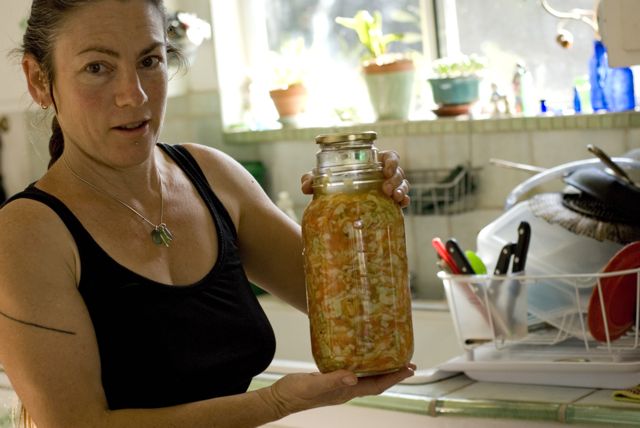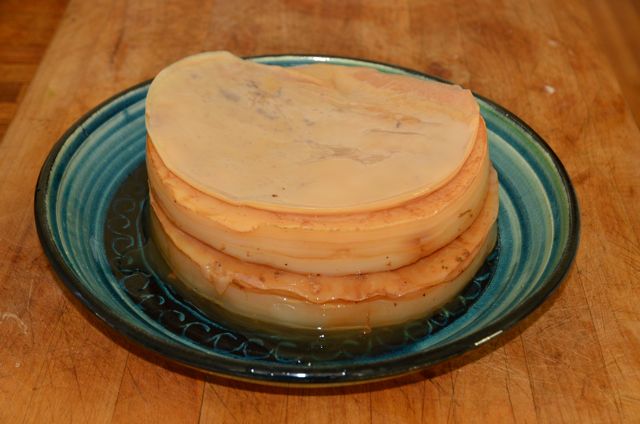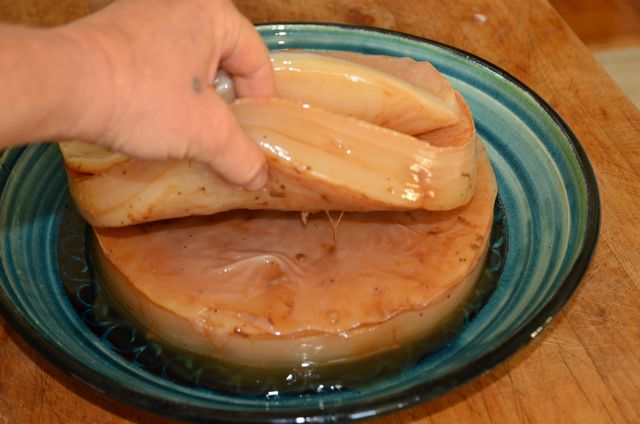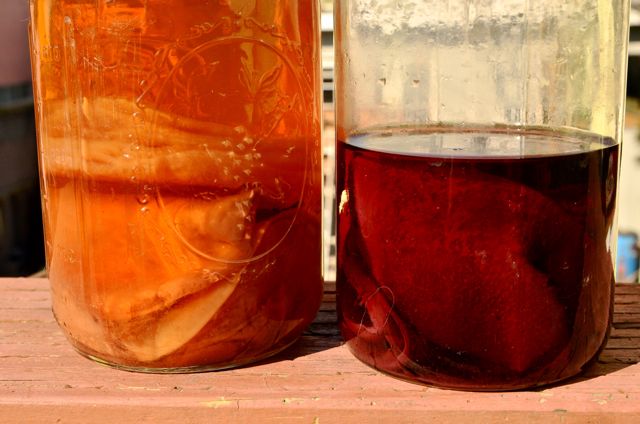Fermentation can be described as "the transformative power of micro-organisms." Partnering with microbes in the kitchen enhances the flavor and in many cases healthfulness of our foods. The process of fermentation is, in a way, about micro-husbandry. You provide the correct temperature and environment for the critter and it does what it does best: eat and multiply. Happy, well fed micro-organisms produce happy flavorful foods.
There are 4 main types of fermentation used in food production. Click the links or scroll down for starter recipes and pictures)
Yeast Fermentation > transforms sugars into Co2 and alcohol
Examples: Beer, wine, mead. Also bread. If you leave your bread starter too long without feeding it, or using it, it will start to go alcoholic. Yeast strains vary in their tolerance to alcohol and drown themselves in it before all the sugars are consumed ( as in a sweet mead). Beer and wine traditionally have all the sugar fermented away.
Acetic Acid Fermentation > transforms the sugars left in wine into vinegar
A vinegar mother looks like a thin flat gelatinous mass (like a miniature kombucha). Traditionally farm wives kept a crock in the corner which they simply threw any old wine into for the aceto-bacteria to work upon. Vinegar fermentation is slow (can take several months to be fully fermented) and works best when you use at least 50% finished living vinegar as a starter.
Lactic Acid Fermentation > transforms the sugars in milk, vegetabes and fruits into lactic acid.
Lactobacilli are of extreme importance to our food culture. They are responsible for a whole slew of cultured dairy products including yogurt, cheese, buttermilk, creme fraiche and more. Lacto-bacilli are also the same critters help to create sauerkraut, dill pickles, kim chi, chutneys, kvass, cured olives and lacto-fermented drinks. Lacto-fermented foods are highly alkalizing, anti-oxidant and offer too many health benefits to list here.
SCOBY ~ Symbiotic Culture of Bacteria and Yeast
It is well known that most microbes live in communities. Even those mentioned above usually live in groups of several species. Sometime yeast and bacteria get together on a commonly liked food substrate and form an ongoing symbiotic relationship. Kombucha is the best known example of a SCOBY. Sometimes called a "mushroom (yeasts are, after all a fungi)." the kombucha mother under good conditions becomes a thick gelatinous mass. The Kombucha drink has been hailed as a cure-all, but the jury is still out. Another example of a SCOBY is sourdough starter culture. The yeast makes the bread rise, and it is lacto-bacilli which make it sour.

Joe's Ancient Orange ~ A fun beginner mead recipe
Ruby's Organic All-Natural Mead
This is my basic mead recipe for a 1 gallon batch (I recommend starting with gallon batches to learn since honey is expensive). I prefer to use all organic "real" ingrediants (not chemicls) and then flavor by infusing once fermentation is well under way (usually at 3-6 months). This involves racking the wine back into an open fermentation vessel and infusing with fruit, herbs or spices for 1-2 weeks. The alcohol absorbes the flavors and fermenting at this later time helps retain the aromatics of the infusion. Depending on how much honey you use you can get a dry mead (low end of honey) or a sweet mead (high end of honey).
Ingredients
3-4.5 lbs orange
blossom or other varietal honey
1.5 cups fresh pressed orange juice
1 tablespoon black tea
1 teaspoon yeast nurtient (from brewers supply) or 1 Tablespoon organic tomato paste if you prefer
1 package lavlin D-47 or champagne yeast
3/4 gallon spring water
Equipment
large pot
2 gallon plastic bucket with airtight lid and 1" diameter hole for
airlock and cork
small bowl
spoon
whisk
ladle
measuring cup
airlock for 1gallon bottle
cooking thermometer
1.Wash everything
in soap & water, Sanitize.
Set on a clean towel.
2. Bring water to a boil in pot. Turn off heat and add honey. Add warm water to your honey jar and shake to get every drop. Stir with whisk
until honey is dissolved. Let sit 15 minutes.
3. Add juice, tea and nutrient to plastic fermenter.
4. Add honey-water mixture to bucket. Cover and let sit until it cools
to 105 degrees.
5. Ladle a small amount of mixture into small bowl and add dry yeast.
let sit for 10 minutes and then add to bucket
6. Whisk vigorously for 2-3 minutes. Cover with lid and insert airlock
into hole.Set in warm location. It should begin bubbling within 24 hours
7. Leave for 2 weeks or until bubbling slows to less than once every 10
minutes. Transfer to 1 gallon bottle and wait 1 year to drink.
To make vinegar you will need to purchase or procure a vinegar mother. In a pinch you can simply use braggs non-pastuerized vinegar as your starter. You can also attempt to catch a wild vinegar strain by simply leavng your ld wine exposed to the air. Once you have obbtained your mother put it in a glass jar (or other non-reactive container, remember we are making acid here). Add your mother and 1 part starter culture to 1 part wine. cover the top of the jar with a cloth (a muslin napkin or piece of old sheet will work) and fix it into place with a rubber band. Set at room temperature our of direct sunlight. It should be ready in about 3 months. decant half of the mixture to use and add more wine. Over time your culture will grow and your vinegar will work more quickly and you can make larger batches.
SAUERKRAUT


A simple vegetable ferment ( a "kraut") can be made from a wide variety of vegetables: carrot, cabbage, daikon, radish, beet, turnip, kale, collards and so on. the only things I do not reccommend are tomatoes, mushrooms or cucumber (which should be dealt with separately as they need extra salt to stay crisp). The important factors are aurface area, temperature, salt and oxygen. If you wish to work with less salt (or no salt) you must be able to store your ferment at 50-55 degrees as it is getting started. The higher the ambient temperature the more salt you will need to add. It is not reccommended to try to ferment vegetables at temperatures over 80 degress. they will rot before the goofd bacteria get a leg up. There is no a specific amount of salt--you can salt to taste, or if you like your kraut extra crunchy, salt to where it is just over the line to too salty for you. The fermenting vegetable will also need an anerobic environment, so they need to be completely submerged in their juices.
1. Cut chop,dice or garte your veggies
2. Massage vigorously with or without salt to get the juices to express.
3. Add herbs or spices (cloves, ginger, garlic, fennel seed, coriander, mustard seed, dill etc)
4. Pack into glass jars & cap loosely. If the juice is not already covering, you can add a little salt brine or a littlw whey. You can also set a weight ( a jar or cup filled with water works) into the jar opening to press the veggies down.
5. let sit at oom temperature for 24-48 hours until the mixture starts to get bubbly and smell tangy. cap lightly and put into the frdige for 1-6 months. If you have access to a root cellar or other spot where temperature remain at an ambient 50-55 degress you can also safely store your ferments in this area.
Once fermented the kraut can keep as much as 2 years or more. Where it is oxidized or moldy at the top, simply scrape that out.
LACTO-FERMENTED FRUIT SODA

A healthful bubbly drink can be made by combining fresh water, a caloric sweetener (sugar, maple syrup, agave etc), flavoring in the form of fruit or infused tea and a starter culture of whey or pro-biotic. Your basic recipe includes 1 cup sweetener and 1 cup whey or 4 Tablespoon liquid pro-biotics per gallon. The culture needs this minimum amount of suagr to get started--if ou wish your drink to be less sweet, simply let it ferment longer and eventually the sugar will be completely digested by the micro-organisms. A cup of this soda has as many beneficial organisms as a portion of yogurt. Here is one of my favorite recipes. Berries also work well and 1 cup of any kind of berry can be substituted for the grapefruit juice & rind.
Lacto-Fermented Lemon-Grapefruit Soda
I gallon glass container with lid
5 lemons
1-2 grapefruits
1 teaspoon sea salt
1 c whey or 1/4 cup liquid pro-biotic
1 c. sweetener
non-chloraminated water
1. Squeeze the lemons & grapefruit into the container.
2. Add the rinds of 2 lemons & 1/2 grapefruit (or less for smaller batches).
3. Add the rest of the ingredients.
4. Treat water if necessary and add to reach the target volume.
5. Cap & shake to dissolve & disperse ingredients.
6. Set in a warm spot for 2-5 days until carbonated. The longer it sits, the less sweet it will get.
6. Strain, bottle & refrigerate.


Kombucha has specific dietary preferences. In order to work it must be made with cane sugar and tea from the tea plant ( not an herbal infusion). It can be decanted and infused with other flavorings after it's primary fermentation. You can bend it with fruit juice, flvored syrups or herbal tea.
Basic Kombucha
Boil 1/2 gallon non-chloraminated water
Infuse with green or black tea (4-5 tablespoon)
Add 1 c. sugar & dissolve
To your fermentation vessel add 1/2 gallon cold water.
Strain tea-sugar micture into fermentation vessel
Let cool to 95 degrees or less.
Add ¼ c vinegar or finished kombucha
Add kombucha mother
Cover with a cloth and elastic
Taste daily. It is finished when it tastes vinegary and effervescent--or simply when it tastes good to you.
Some (like myself) prefer it with some residual sweetness.
